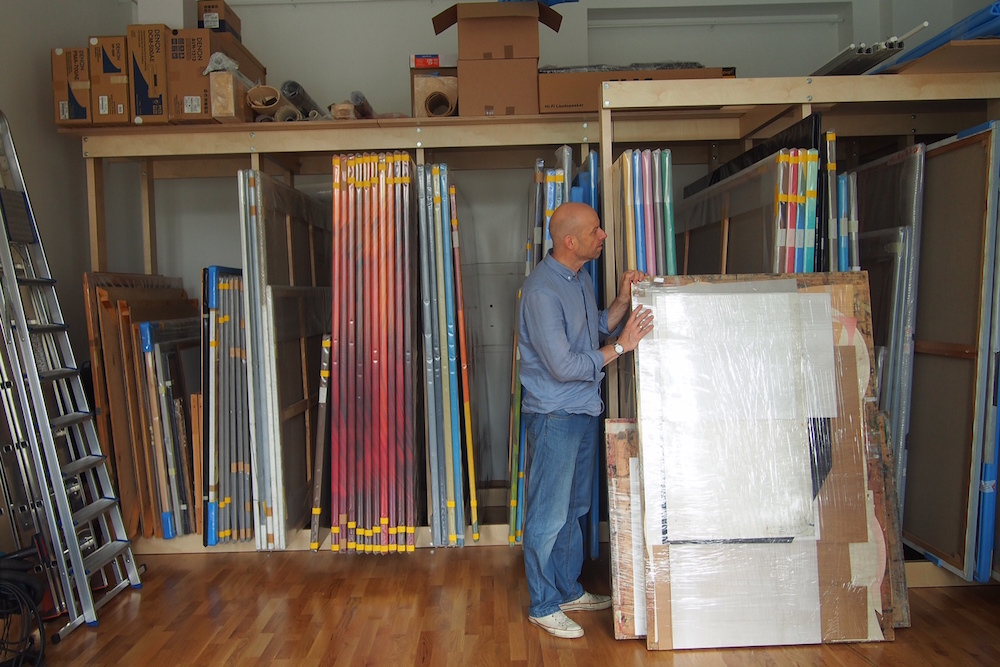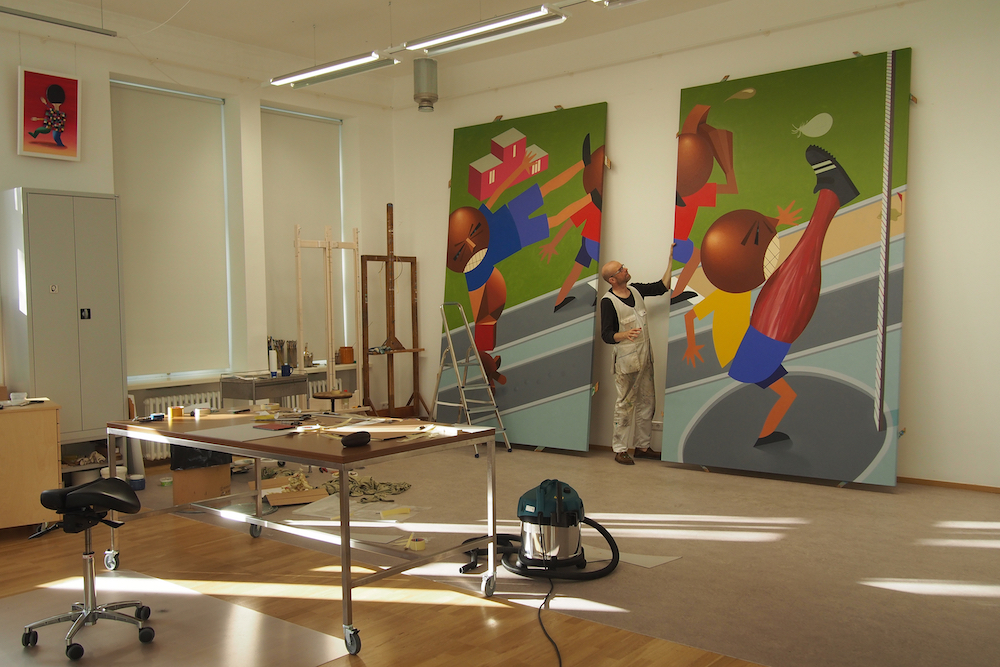Kaido Ole is currently one of (if not the) most prominent painters in Estonia. He lives and works in Tallinn, Estonia’s capital. “The real struggle is about what is going on right now,” the artist says. “I cannot see that since I am part of it. Right now, I don’t know what is wrong or right. The only thing I know is that it is wrong if people start to kill each other.”
One of the paintings in Kaido Ole’s current exhibition Nogank hoparniis shows a cartoon-like figure on a small raft in a river, against a background of green, loosely-painted bushes and brushstrokes. It is called Exploring the Jungles of Abstract Expressionism. In a second, neighbouring painting, daylight is gone, we see the same figure still peddling, half-hidden behind trees in the twilight. Now it is called Hopelessly Lost in the Jungles of Abstract Expressionism. They seem quite an ironic pair, while at the same time pointing to a problem that is relevant for many painters: Does spontaneous abstract mark making still makes sense, or is it something we cannot believe in anymore, or even get lost in?
I meet Ole in his studio in the outskirts of Tallinn, a quiet residential building, where you would not expect to find an artist at work. Before he answers questions, he wants to know what my impression of his show in the Tallinn Art Hall is, which opened the night before. I see Ole as a painter mocking his medium, to the point of undermining it, while at the same time being very driven, determined to find some new spot that not has been occupied yet. The cartoon-like figures in his work seem to function as alter egos and, if you look past the initial twist, these figures are actually involved in quite serious matters. Maybe Ole just chooses a light way to talk about heavy stuff.
“I try to make some mistakes,” Ole says. “There is irony and eclecticism in my work. It is quite hard nowadays to step out of a general way of painting. People choose more or less to stay within the same idea of what they think painting is. They see everything in books and at biennales. I put together very different things, without taking too much care about how things have to look. If they look bad, it is good. Bad taste is the new good, you could say. I try to forget about being a professional. I am using knowledge and skills anyway, even if I don’t want to, but I try not to be so precise, for instance, and to change the proportions of the figures a bit. There is a thin line, between old professionalism and new professionalism.”
It does not look like you don’t use your skills; your paintings are very precise, even if the scenes are awkward, it looks like you are pretty much in control over the scenery.
It is about letting yourself free. Not to care so much about technique. What I am looking for is to get out an essential part of me, which is not so controlled.
Painting is usually quite serious. You act like a bit of a jester, mocking high art and the act of painting. What I am curious about is where you are yourself in these paintings. How do you see the balance between expressing something essential of yourself and commenting on the state of painting?
It is about me as my best friend. I think any artist is showing up as an author in the work, no matter if you paint in an expressionist way or not, also if you paint like I do. Work is very much about the maker, no matter what kind of tricks the painter is playing. To me, it is always very interesting how somebody else is living his life. Why do you choose to be an artist? Or a tram driver, or something else? Why do you make things in this way? Those are interesting questions, and everybody has a slightly different answer. We go to Japan and basically, we find people are the same as we are. But they are also different. Their house, car, food is slightly different, they walk a bit differently. They are the same and totally different. That is interesting. It drives me somehow. If I see some other painter, I can see the power inside his work and how he appears as a person, but I also see how he is formed by the outside, by all that we know. We are formed by all that is painted already; the information, the obvious, the signs of the times, which you cannot escape from. I really appreciate to see other people’s mistakes and also my own when I do something silly. With mistakes, there is the chance to do something differently, to make a move that is different to what we know already.
Your exhibition refers to the first people of Estonia, and also to the end of Estonia. In between, there is an empty space…
In a way, I am avoiding the problem, because the real struggle is about what is going on right now. I cannot see that since I am part of it. Right now, I don’t know what is wrong or right. The only thing I know is that it is wrong if people start to kill each other. If people do not appreciate differences but try to make everything the same, that is not good. Small moves end up in fighting and killing. If you think about the Second World War, it became legal to kill people. Today we mourn because of traffic deaths, but then if you have war it suddenly changes, and people think it is good to kill….
Ole brings out a painting from his storage, which was not included in the show. It shows some cuts in an almost empty canvas. It is connected to the work about the first Estonians he made, showing three dots on the coast. “I tried to paint the first Estonians,” he says, “it was a wrong idea. Then I destroyed the canvas, by cutting through. It was not my plan to destroy, but it happened. Something was rising from inside, like a volcano, it came out. So there you go, I am also an expressionist painter.”
You feel violence can easily erupt, civilization is only a thin layer?
It is a yin-yang thing. You have to control your gunpowder and use it well. And then it comes out. It is childish if people think that if you are controlling things, you have no emotions. I think of all my paintings as containing emotions, even if they are composed. Expressionist painting is often staged because real moments of this kind of anger do not last long. You can be aggressive only for a short time, maybe twenty seconds or one minute, and then it is over. It easily becomes a method, a bit fake, if you paint like that all the time.
You cannot believe in an expressionistic vocabulary anymore? It is too much of a style or a preconceived way of painting?
It depends on who you are, I think there are still some painters who succeed in painting like that. People are just different. You have to paint how you are. But you cannot be a virgin anymore. Nowadays you see yourself from the side as if you were another person. You know already that expressionism is a method and a style. Everything has become legal. You choose this or that approach. It is like politics. What party do you choose? And then you already know how to make the next move. If there is no risk anymore, I think it is bad. It is better to go for this embarrassing moment that you do not know, or that you put yourself in a very stupid position. Actually, there is one artist, Mernet Larson, it is a bit my kind of artist, her work is serious, and it is also ironic. My interest for my latest show was simple: How to represent the human being? It is done so many times, but it can be different again. The irony in my work, it is about me. It is self-irony. Mankind is childish; things are always getting out of control. All these wars, to blow things up, it is not very grown up. Mankind is currently behaving like a teenager.
You feel that basically everything is done in painting?
Of course, not everything is done. It is a lack of imagination to say so. It is also self-centered–as if we, nowadays, have discovered everything and can oversee the situation. It is possible to make new painting, but you have to see it and not many people do. The purpose of art is the same as to be a human being: you have to make the territory wider. For a lot of people it looks like there is only a small territory available and then they start fighting about it. Be happy if there is something you do not understand. It is new territory.
Being an artist is like a short cut to be a human being, you said during the opening…
Often I feel making painting brings exactly the same feeling as when I do something else, which is not art. I do not trust art education so much. It is like making a huge U-turn to get to your goal. You have to find natural sources; maybe the only way is to make this U-turn. A child in the museum asked: Why is this picture better than the other? His grandfather said: Take a chair, take the time to look. After a while, you will realize it. I think it is like that. You need some time. You have to observe something well, you do not need education for that. The whole education is set up to make you disappointed. Only then you find some courage inside yourself to make a personal strong move. Then you feel pressed, and you do something real. At school, you feel it is too much, you ask: what is my life? You throw away all the weight of education; you have to make space to make your own thing. Nobody gives you the key. And what you need is a personal key. All together we get sixteen years of education. People say you have to read this, you need that knowledge. You can also just take a seat and watch a picture and you understand everything.













